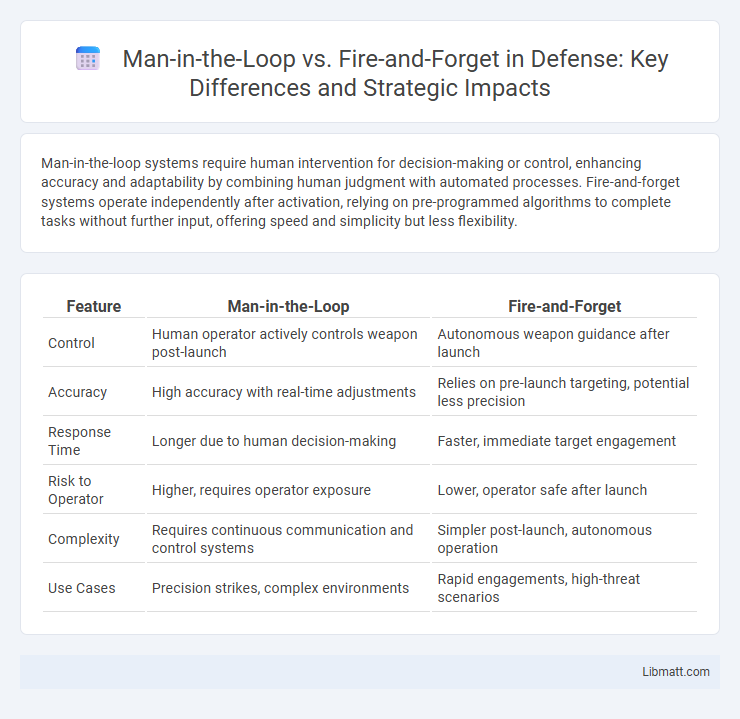Man-in-the-loop systems require human intervention for decision-making or control, enhancing accuracy and adaptability by combining human judgment with automated processes. Fire-and-forget systems operate independently after activation, relying on pre-programmed algorithms to complete tasks without further input, offering speed and simplicity but less flexibility.
Table of Comparison
| Feature | Man-in-the-Loop | Fire-and-Forget |
|---|---|---|
| Control | Human operator actively controls weapon post-launch | Autonomous weapon guidance after launch |
| Accuracy | High accuracy with real-time adjustments | Relies on pre-launch targeting, potential less precision |
| Response Time | Longer due to human decision-making | Faster, immediate target engagement |
| Risk to Operator | Higher, requires operator exposure | Lower, operator safe after launch |
| Complexity | Requires continuous communication and control systems | Simpler post-launch, autonomous operation |
| Use Cases | Precision strikes, complex environments | Rapid engagements, high-threat scenarios |
Introduction to Man-in-the-Loop and Fire-and-Forget
Man-in-the-loop systems require continuous human interaction to monitor, control, and make decisions during operation, enhancing precision and safety in complex environments. Fire-and-forget technology operates autonomously after activation, relying on pre-programmed instructions or sensors to complete tasks without further human intervention. Your choice between these approaches depends on the level of control and adaptability needed in your specific application.
Defining Man-in-the-Loop Systems
Man-in-the-loop systems integrate human judgment directly into automated processes, allowing real-time decision-making and adjustments during operations. These systems contrast with fire-and-forget technology, which executes tasks autonomously without further human intervention after initiation. Your ability to influence outcomes in man-in-the-loop setups enhances precision and adaptability in complex or unpredictable environments.
Understanding Fire-and-Forget Technology
Fire-and-forget technology enables systems to operate autonomously without requiring continuous human input after activation, relying on embedded sensors and guidance algorithms to complete their mission. Unlike man-in-the-loop systems, which depend on real-time human decision-making and control, fire-and-forget reduces operator workload and increases speed of response. Your ability to focus on strategic oversight benefits when deploying fire-and-forget solutions that execute tasks independently with minimal intervention.
Key Differences Between the Two Approaches
Man-in-the-loop systems require continuous human supervision and decision-making, ensuring real-time adjustments based on evolving situations, whereas fire-and-forget technology operates autonomously after launch, relying on pre-programmed parameters. The key difference lies in control: man-in-the-loop emphasizes human judgment and intervention while fire-and-forget prioritizes automated completion without human input. Your choice between these methods depends on the need for flexibility versus speed and simplicity in mission execution.
Advantages of Man-in-the-Loop Control
Man-in-the-loop control offers enhanced decision accuracy by allowing human operators to assess complex or ambiguous situations, reducing the risk of errors in critical operations. This approach provides adaptability and real-time adjustments, improving system responsiveness compared to fire-and-forget systems that lack feedback mechanisms. You benefit from increased operational safety and better handling of unforeseen events through continuous human oversight.
Benefits of Fire-and-Forget Automation
Fire-and-forget automation significantly reduces human intervention, enabling faster decision-making and improving operational efficiency in high-volume environments. Its design allows processes to run autonomously, minimizing errors and freeing up your team to focus on more strategic tasks. This approach is especially beneficial in scenarios requiring consistent, repeatable actions without real-time monitoring.
Challenges and Limitations of Each Method
Man-in-the-loop systems face challenges such as increased latency and the risk of human error, which can slow down decision-making and reduce operational efficiency. Fire-and-forget methods, while faster and more autonomous, suffer from limitations like lack of real-time adaptability and potential for incorrect target engagement. Your choice between these methods should consider trade-offs between control precision and speed in dynamic environments.
Real-World Applications and Use Cases
Man-in-the-loop systems are extensively used in military drone operations and industrial automation to allow real-time human intervention, ensuring high accuracy and adaptability in complex environments. Fire-and-forget technology is predominant in missile guidance systems and autonomous sensors where rapid, independent target engagement is critical for mission success. Both approaches are applied in security surveillance and robotic systems, with man-in-the-loop offering precision control and fire-and-forget enabling swift, autonomous responses.
Security and Ethical Considerations
Man-in-the-loop systems enhance security by allowing human oversight to intervene in critical decisions, reducing risks of automated errors and ethical breaches in sensitive operations. Fire-and-forget technologies prioritize rapid response but can raise concerns due to lack of accountability and potential unintended consequences without real-time human control. Your choice between these approaches impacts the balance of operational efficiency, ethical responsibility, and security assurance.
Future Trends in Autonomous and Human-Supervised Systems
Future trends in autonomous and human-supervised systems highlight a growing integration of man-in-the-loop approaches with advanced AI capabilities, enhancing decision accuracy and ethical oversight. Fire-and-forget technologies will continue evolving with improved sensor fusion and real-time data processing but may face limitations in dynamic, unpredictable environments where human intuition remains crucial. You can expect these systems to increasingly complement each other, balancing autonomous efficiency with human judgment for safer and more adaptable applications.
man-in-the-loop vs fire-and-forget Infographic

 libmatt.com
libmatt.com